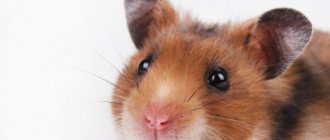Ornamental species of hamsters bred in captivity are very gentle creatures. They are susceptible to various diseases that can arise due to food and water that is stale or treated with substances harmful to the animal, sudden changes in temperature and other things that are less significant for larger animals. If you suddenly find that your beloved hamster is lying down and not moving, do not panic, you need to act quickly and without emotion.
In some cases, it is necessary to provide first aid to your pet before receiving qualified veterinary treatment. After delivering the hamster to the clinic, you need to tell the doctor what preceded this condition and what resuscitation measures were provided.
It is important that before starting any action, you need to analyze the situation: when the changes in the animal’s behavior began, what contributed to this, what symptoms appeared, how long it lasted.
Reduced ambient temperature
If the animal was healthy and vigorous, and suddenly you noticed that the hamster was lying down and not moving, then first of all you need to assess the temperature. When the air temperature is below 20⁰C for a long time, the rodent can hibernate.
Another reason for deep sleep is a strong reduction in the amount of food - in this case, the animal is starving. Lack of lighting also leads to longer sleep.
If this is really hibernation, then the animal’s body is soft and warm (but lower than usual). Breathing and heartbeat are slow. Therefore, you need to observe the animal for five minutes. To assess the heartbeat, place the thumb and index finger on either side of the hamster's chest under the paws. During hibernation, only four beats can be recorded in one minute.
To wake up a pet, it must be placed in a well-heated room with a temperature of +25⁰C. Prepare clean water in the drinking bowl and food in advance. A healthy animal will wake up on its own in two to three days. It is acceptable to wrap the rodent in a warm blanket or place the cage on bottles of warm water.
There is no need to force events. However, it is necessary to monitor him during this time to see if any odor has appeared or if the body has become numb.
Why do hamsters die?
Djungarian and Syrian hamsters are very cute, funny, unpretentious animals to keep and care for. Therefore, many people keep them as favorite pets. But unfortunately, the life expectancy of a hamster is short.
Even with proper maintenance and systematic care, the animals live from 1.5 to 2.5–3 years. At the same time, there are many factors that can accelerate the death of a small pet. And it’s not always possible to understand why hamsters die and how to help your pet. Why do hamsters die? How to understand that a dzhungarik is dying? What to do if your hamster dies?
Main causes of death
If the rodent does not receive proper attention from you, if the rules of care and maintenance are violated, the life expectancy of Djungarian and Syrian hamsters is significantly reduced. In some cases, the death of the animal may occur at the age of 5–6 months.
Do not forget that hamsters are very delicate, fragile and delicate creatures, and every year it becomes more difficult for them to withstand the effects of adverse factors.
Considering that many parents buy hamsters as pets for their children, the death of a little friend can cause severe distress or even psychological trauma in a child.
Therefore, you need to know why hamsters die, the main causes and signs of their death.
Causes of death of hamsters:
- unbalanced, unhealthy diet;
- feeding with low-quality feed;
- non-compliance with care standards, violation of maintenance rules;
- frequent stress;
- viral-bacterial diseases, fungal infections;
- unfavorable microclimate conditions in the room where the pet is kept (temperature, humidity level);
- autoimmune diseases;
- heart pathologies;
- age-related changes in the body;
- congenital, chronic pathologies;
- old age.
Female hamsters often die during pregnancy and childbirth due to the fact that during this period the body of small pets becomes most vulnerable to adverse factors. In addition, too early pregnancy at 3-4 months can ruin your pet.
Death of a hamster caused by cancer
Prolonged overheating, hypothermia, sudden changes in temperature conditions, and high humidity pose a great danger to the lives of Djungarians and Syrians. The health of rodents is negatively affected by drafts, dampness, and cold. Do not forget that hamsters are heat-loving animals, and low temperatures can cause coma and death. This is especially dangerous for small hamsters.
In the room where the pet's cage is located, the temperature should be between 22–25 degrees Celsius. Prolonged hypothermia leads to a slowdown, disruption of metabolic processes, and contributes to the development of colds, which pose a mortal danger to small animals.
You need to understand that the lifespan of pet rodents directly depends on the quality of care.
Wrong diet
Hamsters are quite voracious omnivorous creatures. They happily eat everything that the owner offers. At the same time, we should not forget that Djungarians often have digestive problems.
The intestines of these pets occupy almost 70% of the total weight. Therefore, foods from our table (sausages, smoked meats, salty, spicy foods, fatty varieties of hard cheeses) should absolutely not be given to hamsters.
Digestive disorders in hamsters, inflammation of the digestive tract can be caused by moldy food, wet grass, excessive eating of soft food, and lack of fiber.
The death of a pet can be caused by improper feeding
You should not treat your rodent to foods that will cause digestive disorders. Blockage and acute inflammation of the gastrointestinal tract can cause the early death of your beloved hamster.
Stress
Hamsters are very susceptible to stress.
A rude, disrespectful attitude towards an animal, unsanitary conditions in a cage, a monotonous diet, lack of toys, entertainment, an improperly equipped cage, other pets in the house or overly aggressive relatives can cause severe emotional shock that a small pet may simply not withstand. Do not forget that stress greatly weakens the body of animals, regardless of their species.
The heart of rodents beats 180 beats per minute, so it wears out quickly.
Severe stress and fear can cause cardiac arrest in a small pet. In addition, hamsters can have a stroke. Due to hemorrhage, the rodent is paralyzed, but death does not occur immediately.
Diseases and injuries
Djungarian hamsters, Syrians, and representatives of other breeds are susceptible to diseases of various etiologies throughout their lives. Bacterial, invasive, viral diseases, endocrine pathologies (obesity, diabetes mellitus) often lead to the death of rodents.
Of particular danger to dzungarians are cancerous tumors, inflammation of the cheek pouches, respiratory infections, and mycoses. A crushing blow to the health of a small pet is caused by endoparasites, which provoke systemic disorders in the rodent’s body.
When kept together, hamsters can injure each other.
You can recognize that a hamster is dying by its changed behavior. Dzungarik becomes lethargic, inactive, and reluctant to be held. Possible loss of coordination of movements, muscle spasms. The pet has dull, tousled fur and a dull look.
Before death, the rodent can be completely paralyzed. There may be other symptoms that indicate illness (cough, difficulty breathing, vomiting, upset stomach).
Moreover, if all the hamsters in the cage died, one of the most likely causes is an acute viral or bacterial infection.
Sick hamster
Hamsters often die due to improper treatment. Almost all human medications are deadly to small rodents. Therefore, you should not self-medicate. Consult your veterinarian. Only a ratologist or veterinarian will be able to select adequate therapy for a sick hamster.
Another common cause of death for hamsters is severe injuries and bruises incompatible with life, which a hamster can receive due to improper home arrangement, in case of escaping from a cage and falling from a great height.
Careless handling also shortens the life of pets.
For example, while playing with a pet, a child may accidentally squeeze the hamster too much or drop it from a height, which will lead to a fracture and cause spinal injury and internal hemorrhage.
It is also worth noting that when several pets are kept together, they can get injured in fights with their relatives. Don't forget that hamsters are territorial animals, and if you keep several hamsters in one cage, they will constantly fight. Strong individuals will injure weak relatives. In this case, the pet may receive injuries or injuries that are incompatible with life.
Death from old age: how hamsters die
The main cause of natural death of all hamsters without exception is age-related changes in the body (wear and tear of the myocardium, blood vessels). Unfortunately, nature has given rodents a rather short life span, and all animals, without exception, die of old age. You can tell that a hamster is dying of old age by its changed behavior.
Signs of aging:
- cloudy, unclear look;
- decreased activity;
- decreased appetite, refusal to feed;
- poor coat condition;
- the appearance of bald spots, bald spots on the neck and head.
old hamster
Before death, the hamster eats less, stops stocking up, does not spend time on the running wheel or drum, has little interest in the outside world, and almost all the time sits motionless in the corner of the cage or does not leave its house. The pet moves slowly, very carefully.
If you see your hamster dying, try to save it. Of course, if he has cancer or is old, it is impossible to help the rodent.
The death of a hamster can be confused with paralysis or sound sleep. Therefore, do not rush to bury the rodent. Make sure the pet is really dead. If the animal is dead, it will have no pulse, no breathing, and the body will be cold.
Dead hamster
It is difficult even for a veterinarian to determine exactly when death from old age will occur. But still, in order for the retirement period to be as favorable as possible for the rodent, the owners must surround their little pet with affection, attention and care.
Source: //localvet.ru/veterinariya/gryzuny/gibel-homyaka
Increased ambient temperature
Small rodents, despite the fact that in the wild they can live in steppes, deserts and semi-deserts, do not tolerate heat well.
Prolonged exposure to high temperatures can lead to heat stroke.
Signs of this condition will be:
- Trembling when touched
- Convulsions
- Weakness and indifference
- Coordination of movements is impaired
- The hamster lies on its side and breathes heavily
Sudden overheating can lead to heart failure, which can be fatal. Such rodents do not have the body's natural protective functions in the form of sweat or mouth breathing.
If the animal is lethargic, but the exposure to high temperatures has not been for a long time, then the first aid will be to move it to a cooler room and spray cold water over it from a spray bottle.
A quick way to cool the body is to place the animal under a stream of cold water, holding the muzzle so that the hamster does not choke.
If the animal begins to come to life, it is important to give it water using a syringe or pipette.
In an unconscious state, the rodent will not be able to swallow liquid. To replenish the water-salt balance, a solution of sodium chloride or ringer is injected subcutaneously. Large breeds can be injected from four to eight milliliters, dwarf and Djungarian hamsters - two milliliters.
In an emergency, when veterinary care cannot be obtained, prednisolone is injected intramuscularly into the hind leg using an insulin syringe.
For a Syrian hamster, the dose is 0.1 ml, for a Djungarian hamster - half as much.
Other diseases
Pets do not get sick very often if they are properly cared for in a timely manner and fed a balanced diet, with the exception of congenital pathologies. In addition to a specific disease characteristic of animals - inflammation of the cheek pouch, they are also affected by viruses, bacteria, and parasites. As a result, the animal becomes inactive and refuses food and drink. If you do not pay attention to the unnatural behavior of your ward and do not provide timely medical assistance, the pet may die.
Did you know? Golden Syrian hamsters have four toes on their front feet and five
-
on the rear.
For example, as a result of a blow or a fall from a height, difficulty breathing, twisting of the head and refusal to eat may occur. In this case, it is advisable to contact a ratologist. If the hamster is already at an “advanced age,” then it can become severely paralyzed. On average, the lifespan of these rodents is 1.5–2 years. Some live up to three years.
Pneumonia
The development of the disease is possible when the animal’s immune defense is weakened due to a deficiency of vitamins, minerals, and amino acids in the feed.
The causes of such a serious disease may be:
- prolonged hypothermia as a result of a draft or low temperature combined with high humidity in the room where the animal lives;
- virus;
- chronic otitis, in which the animal shakes its head, and wax accumulates in the auricle, a crust forms and an unpleasant odor emanates;
- hypo-or vitamin deficiency as a result of an unbalanced diet;
- ophthalmological diseases.
Did you know? Fluffy pets cannot boast of good eyesight - they are nearsighted and trust their sense of smell more; moreover, they do not distinguish colors, that is, they are color blind.
Symptoms indicating the development of pneumonia include:
- rapid breathing, accompanied by sniffling, wheezing, gurgling in the lungs;
- profuse mucopurulent discharge from the nose and eyes;
- lethargic state;
- coughing attacks, shortness of breath;
- pallor of the mucous membranes;
- the animal stops eating;
- the animal freezes in one place, without moving, because he is choking.
Pneumonia is treated with antibiotics. The drug Baytril, 2.5%, is suitable for small rodents. A dose of 0.4 ml is calculated for an animal weighing 1 kg. The average weight of a Djungarian hamster is 50 g. Therefore, a dose of 0.01 ml will be sufficient for him.
The injection is given under the skin daily for two weeks. Additionally, sulfonamide drugs are used, which have an antimicrobial effect. If treatment is carried out in a timely manner, the hamster will fully recover.
Poisoning
Symptoms of the pathological condition include:
- bowel dysfunction;
- rumbling in the stomach;
- loss of appetite;
- lethargy.
The best option would be to consult a specialist to find out the cause of the digestive process disorder, determine the correct diagnosis and prescribe appropriate treatment. These symptoms accompany not only poisoning, but also gastrointestinal diseases, food allergies, and enteritis.
Important! Dehydration, which is the result of severe diarrhea or elevated body temperature, can cause lethargy, weakness, exhaustion, slow breathing of the animal and very rapid death.
Factors that can provoke this condition in a patient include:
- violation of feeding regime;
- the use of a diet of poor quality or poor in nutrient ratios;
- the effect of various toxins on the rodent’s body.
If there is a suspicion that the baby has eaten low-quality food, it is advisable to give him half a tablet of activated carbon and fill the drinking bowl with fresh water. You can use Enterosgel - it helps remove toxic substances. To restore the acid-base balance, use "Regidron". After providing first aid, it is advisable to show the hamster to a veterinarian.
Diarrhea in a rodent can be triggered by a sudden change in diet or too large a dose of fresh vegetables, fruits and herbs. Very soft or runny stools will leave your pet's fur in the anus area wet or dirty. With severe diarrhea, there is a risk of dehydration, so it is advisable to force water on your pet.
Find out what diseases hamsters have.
Vegetables, fruits, and greens should be excluded from the diet and the pet should be switched to dry food. Feed your hamster raspberry leaves and rice water - these foods will help hold the stool together. If after 2 days the diarrhea has not stopped, take your ward to the veterinarian - perhaps the digestive upset was caused by other reasons. After bowel movements are restored, gradually introduce small doses of fresh fruits and vegetables into your diet.
Tumors, metastases
Animals are often diagnosed with pathological formations on the body, limbs, and ears. The reasons for their development are different. For example, a lump appears as a result of an injury, a severe bruise when falling from a height. Treatment begins with a diagnosis by a physician-ratologist.
If a benign or malignant tumor is detected, surgery is prescribed. If the tumor is located in a hard-to-reach place, for example, in the oral cavity, or metastases are found in other organs, veterinarians advise euthanasia, because Treatment methods do not give the desired results.
Main causes of heavy breathing
The animal's condition can worsen due to various reasons:
- Pneumonia is the development of inflammatory processes in the lungs. Characterized by wheezing, gurgling and wheezing sounds when breathing. An indicator of the disease is also discharge from the nasal cavity observed over several days. In this case, the hamster becomes inactive, inactive, does not approach the feeder, and drinks little. It becomes difficult for him to breathe, which hinders his movements. The animal simply lies and tries to move less.
- Tumors or metastases in the lungs. Tumors can be benign or malignant (cancerous). Catalysts for their formation can be viruses, a previous infectious disease, decreased immunity, disturbances in the hormonal system, injuries and other reasons. If the tumor begins to spread throughout the body, metastases appear. Their localization may also be in the lungs.
- Poisoning. Intoxication factors: spoiled food or low quality water; eating poisonous plants or grains; ingress of toxic substances into food or water. Signs of poisoning include difficulty breathing, thirst, lethargy, refusal to eat, vomiting, and diarrhea.
- State of agony. If the hamster is breathing heavily and does not move, then this may be an indicator of the pre-mortem stage. Occurs as a result of a serious illness.
Article on the topic: Rabies in hamsters - one hundred percent fatal, signs and symptoms of the disease
Heatstroke
I would like to highlight heat stroke in hamsters as a separate point. They are very susceptible to high temperatures and open sun. This is due to the lack of protection against overheating. Signs of heat (sun)stroke:
- the hamster breathes heavily through his mouth;
- the animal looks weakened;
- convulsive syndrome may appear;
- movements become uncoordinated.
With severe overheating, heart failure develops, which leads to death. It can occur either instantly or after a few days, when all organs gradually fail. Heat stroke occurs in the following situations:
- transporting a pet by road during the hot season;
- placing the cage near a window or on a balcony, as well as near radiators or heating devices;
- non-compliance with the optimal microclimate (high temperature and humidity in the room).
In some cases, it is difficult for the owner to understand why his pet is breathing heavily and hardly moving. For example, if he noticed this when the sun was no longer there, or it stopped falling on the cell.
Treatment of hyperventilation syndrome
Most patients with hyperventilation syndrome believe that they are suffering from a terrible fatal disease, which only makes the situation worse. Therefore, the first stage of treating the disease is to influence the patient on a subconscious level. Changing the patient's attitude towards his state of health, combined with the correction of psychogenic disorders, is the first step towards recovery.
The primary task of the doctor treating hyperventilation disease is to demonstrate to the patient the complete absence of organic changes, even despite the severity of the symptoms
It is important to prove the truth that it is simply impossible to die during a hyperventilation crisis, and also to demonstrate how the severity of the crisis state of the disease depends on internal tension. Sometimes this is enough to cope with the disease
And sometimes awareness of the safety of the disease and a changed attitude towards it are only half the way.
Breathing exercises that teach breathing with the diaphragm have proven themselves well. It allows you to learn how to breathe correctly and maintain the ideal proportion of inhalation and exhalation (1:2). At first, such exercises last 3-5 minutes until the body gets used to them. Over time, the duration of gymnastics increases.
Psychotherapeutic methods of treating hyperventilation syndrome stand apart. With the help of behavioral therapy, the method of suggestion, psychoanalysis and other methods of influencing the brain and subconscious, patients begin to look differently at the disease and its severity.
Hyperventilation syndrome is often treated using biofeedback. This method has proven itself well in medical practice. Its essence is to control body functions. In the case of hyperventilation syndrome – control of respiratory function.
It is important to change your lifestyle, as well as your rest and work schedule. It is necessary, if possible, to exclude night shifts and overtime, and sleep should be complete every day
Walking and moderate physical activity should become mandatory. It’s better to spend weekends in a new environment in nature: fishing, relaxing in the countryside, and so on. It is important to stabilize the psychological component of the body, so it is necessary to do what you love as often as possible, get rid of stressful situations and have proper rest.
The complex of drug treatment for hyperventilation syndrome consists of various drugs:
Vegetative agents: β - adrenergic blockers (Metoprolol, Anaprilin), Bellataminal, Belloid, Bellaspon, Platyfillin;
Drugs aimed at correcting psychological disorders: tranquilizers (Grandaxin, Gidazepan, Afobazol, Adaptol and others), antidepressants (Cymbalta, Amitriptyline, Sirlift, Prozac, Coaxil and so on), antipsychotics (Ridazine, Eglonil), sedatives (Corvalol, Persen, Dormiplant, valerian tincture and others);
Metabolic drugs (Actovegin, Riboxin, Mildronate and others), B vitamins (Neurobeks, Milgamma);
Drugs that reduce muscle-nervous excitability: products with magnesium (Magne B6), calcium (Calcium Chloride, Calcium Gluconate), vitamin D2.
In the treatment of hyperventilation syndrome, drugs necessary for use during a crisis are also used (Anaprilin, Platyfillin). They help alleviate the patient’s condition and cope with symptoms. A simple method will also help you overcome the crisis: you need to continuously breathe into a plastic bag. You can't take your face off of him. As a result of such breathing, more carbon dioxide will accumulate in the bag, which helps to overcome the crisis of hyperventilation syndrome.
The course of drug treatment for hyperventilation syndrome usually lasts more than 2 months. However, the list of medications and the treatment plan must be drawn up by the doctor individually for each patient, depending on the symptoms, the severity of their course, the stage of advanced disease, the characteristics of the body, drug intolerance, and so on.
Hyperventilation syndrome certainly spoils life and significantly reduces its quality. Despite the severity of the symptoms, the disease is not fatal. And for a successful recovery, the patient must understand this truth. And in order to finally cope with the disease, the intervention of experienced specialists in the field of psychology (psychotherapy) and neurology is necessary.
How to introduce a treat into the communication process
Adding a treat for the animal is the second step towards building trust. If the pet is already completely accustomed to your hand and is not afraid of it at all, you can safely move on to this step. To do this you will need a treat, it could be:
- seed;
- nut;
- a piece of fruit or vegetable;
- greenery.
You need to put a treat on your fingertips, lower your hand into the cage and carefully treat the animal.
Next, you can place a treat on your palm and invite the hamster to climb on it to take the treat. As a result, the animal will sit in your palm and calmly absorb the food offered.
At the moment when your pet sits on your hand and eats a treat, you can gently stroke it with your second hand. If the animal accepts your affection without fear, you can learn to take your pet in your arms
Diagnostics
A thorough examination and an equally detailed collection of anamnesis and complaints are the most important components of the diagnosis of hyperventilation syndrome. The disease always causes a large number of complaints about the functioning of certain systems and organs, which can immediately lead to the idea of hyperventilation syndrome. However, a final diagnosis can only be made if organic diseases of the organs and systems that the patient complains about are excluded. To confirm their absence, additional procedures are prescribed: ultrasound of the abdominal organs, ECG, ultrasound of the heart, spirography and others.
Careful questioning of the patient usually reveals certain anxieties, high emotional stress and other changes. This is called a positive psychogenic analysis, which also leads the doctor to think about hyperventilation syndrome.
The disease can be detected using a simple and free method that does not require special equipment. The patient needs to breathe frequently and deeply for 5 minutes. If hyperventilation syndrome is truly present, then the symptoms will begin to manifest themselves. Since when symptoms of the disease appear, the amount of carbon dioxide in the exhaled air and blood decreases, after the onset of symptoms the patient needs to breathe air with a 5% carbon dioxide content (in a clinical setting) or breathe into a plastic bag. This will help relieve symptoms.
Medical researchers have developed a unique questionnaire, the results of which can diagnose the disease in 9 out of 10 cases.
The diagnosis of hyperventilation syndrome cannot be made on the basis of one specific symptom and the results of additional studies that refute the problem with the disturbing organ or system. After all, disorders of the respiratory system may also indicate the presence of a number of other diseases, much more terrible (heart failure, bronchial asthma, and so on). Only the doctor’s individual approach to the patient, combined with modern research techniques and a complete comprehensive examination, will help make the only correct diagnosis.
Temperature-related disorders
If the hamster did not show the slightest signs of illness and suddenly fell into an unconscious state, it may be hibernating. In the natural environment, Djunga hamsters retire in winter, experiencing cold weather, periods of lack of food and insufficient lighting. The other extreme is overheating of the hamster, and this is much more dangerous than cooling, since the small animal is absolutely defenseless against high thermometer readings. It is overheating that most often becomes the cause of death for a rodent.
Article on the topic: Why does a hamster itch and bite itself, what to do?
Low room temperature
Turning off the heating or leaving a window open for a long time on a frosty day can cause the hamster to fall into torpor. In this case, the body will be very cold, and the heartbeat will slow down significantly - to one beat every fifteen seconds. A sleeping hamster barely breathes and due to its small size it is quite difficult to determine how intense the breathing is and whether it exists at all. But if the body is soft to the touch, this means that the rodent is alive.
To awaken it, you need to move the cage to a room with a temperature above +20 degrees. The hamster will wake up in 2-3 days and care should be taken that the feeder and water bowl are full when he wakes up. This is especially important, since during hibernation a rodent wastes a very large amount of energy and its health will depend on how quickly it replenishes it with food. A hamster left hungry after hibernation may develop serious liver problems.
This method of awakening is optimal, since it is close to how a hamster wakes up from hibernation in its natural environment, but the process can be accelerated:
- Wrap the hamster in a warm cloth or down mitten, place it in a cage and move it to a room with a high temperature.
- Fill several bottles with hot water, place them in a row and place the cage on them. Heat will be transferred through the bottom, warming the hamster
Important! Try not to let your hamster hibernate again. To do this, you need to maintain the temperature in the room where the cage is above +20 degrees, make sure that a sufficient amount of sunlight penetrates into the hamster’s house, and that the rodent always has the necessary amount of food and drink.
Article on the topic: Tumor in a hamster: causes and treatment (bumps on the neck, abdomen, sides and other parts of the body)
Treatment of dyspraxia
Treatment for dyspraxia should be comprehensive. Depending on the type and severity of the disease, neurologists, psychologists and speech therapists should take part in the treatment.
Tips for parents:
Encourage and help your child acquire special skills
Praise the child for any attempts to perform an action, without paying attention to the result. Be sure to follow a daily routine
Set clear and understandable goals for your child.
It is better to start with those activities that the child himself likes.
Be patient with your child.
Games to develop coordination abilities in children with dyspraxia:
"To the touch".
(develops fine motor skills of the hands, touch, tactile sensitivity).
Up to 10 small objects are placed in an opaque fabric bag, after showing them to the child: a pen, a bottle cap, a notebook, a remote control, etc. The child identifies the objects in the bag by touch.
"Lock".
(develops motor skills of small muscles of the hand, oral coherent speech, memory and imagination).
While reciting the text: “There is a lock on the door.
Who could open it? They pulled, twisted, knocked and opened!”, there are rhythmic quick connections of the fingers into the lock, then the handles are pulled in different directions, the hands with clasped fingers move away from themselves - towards themselves, the bases of the palms tap each other, the fingers disengage, the palms spread apart to the sides. Repeats several times.
“Whose horse is faster?”
(develops coordination and speed of movements of large and small muscle groups, forms correct posture, trains attention, improves vision and hearing, coordinates movements of the torso and limbs).
You need 20 cm long sticks, laces or pieces of rope, toy horses or any other toys.
Children sit on chairs and hold sticks in their hands, to which toy horses (or other toys) are tied by laces at a distance of 15-20 steps. At the signal, the children begin to wrap the string around the stick, bringing the toy closer to them.
"Catch the ball."
(develops attention, memory, acquires ball playing skills).
The players stand in a circle. The driver in the center throws the ball up and calls the player's name. The named player must catch the ball. If the ball is not caught, the player changes places with the driver. The one who drives the least wins.
The diagnosis of dyspraxia can only be made by a pediatrician or a pediatric neurologist or neuropsychiatrist. Make an appointment by calling the single contact center in Moscow +7 (495) 775 75 66, use the service to see a doctor or contact the clinic reception.











